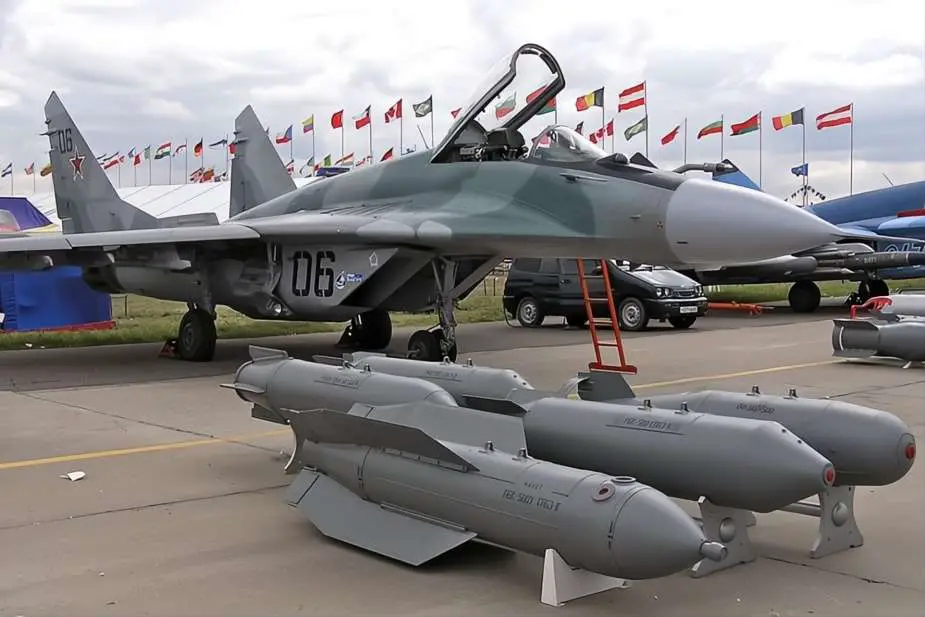Russia to field in Ukraine new PBK-500U guided cluster glide bomb with stealth features
As reported by TASS on January 10, 2024, the Russian state-owned company Rostec is preparing to begin production of its latest aerial bomb, named the PBK-500U SPBE-K Drel ('Drill') glide bomb. This advanced munition is designed for use against armored vehicles, ground-based radar stations, and control centers of missile systems. It also incorporates features intended to reduce its detectability by enemy radar systems.
Follow Army Recognition on Google News at this link

Similar to the basic version of the PBK-500U, the Drel likely employs an inertial guidance system (INS) supplemented by satellite correction systems like GPS and GLONASS. (Picture source: Yandex)
The bomb's full name, PBK 500U SPBE-K, provides an insight into its features. PBK signifies Gliding Bomb Cassette, '500' denotes its caliber and weight at 540 kilograms, 'U' indicates it is a controlled bomb, and SPBE-K stands for Self-Aiming Combined Combat Element. The name "Drill" was chosen by the original developers at NPO Basalt, as the bomb was originally designed to penetrate the upper, less protected portions of Main Battle Tanks (MBTs).
Similar to the basic version of the PBK-500U, the Drel likely employs an inertial guidance system (INS) supplemented by satellite correction systems like GPS and GLONASS. This passive guidance system eliminates the need for direct contact with the target before or after launch, which is considered important for the safety of the attacking aircraft. The bomb operates on a principle of precision targeting. Depending on the mission, the bomb can be equipped with various cluster warheads or monoblock warheads.
As the PBK-500U SPBE-K Drel approaches the target, it deploys 15 submunitions via parachute, designed to penetrate enemy armor and defenses effectively. The bomb is said to be equipped with thermal sensors, allowing it to detect "cold" targets, such as tanks with their engines turned off. Moreover, the bomb incorporates a recognition system to distinguish between enemy vehicles and friendly ones.
A key safety feature of the Drel bomb is its integrated self-destruct mechanism. In cases where the bomb misses the intended target, it is programmed to self-destruct, minimizing the risk of collateral damage. Additionally, the bomb is said to have some resistance to electronic warfare and radar detection.
A glide cluster bomb, such as the PBK-500U SPBE-K, combines elements of glide bombs and cluster munitions. Glide bombs are designed to be released from a distance and glide toward the target, allowing for deployment outside the range of enemy defenses. On the other hand, cluster munitions release multiple smaller explosives, targeting a variety of objectives like armored vehicles, personnel concentrations, or radar stations.
As the glide bomb does not require aircraft to enter the range of enemy air defenses due to its self-aiming SPBE-K elements, various Soviet-era and Russian aircraft are expected to serve as carriers for the PBK-500U SPBE-K, including the MiG-29K, MiG-29SMT, MiG-35, Su-24M, Su-25SM, Su-25SM3, Su-30, Su-30SM, Su-33, Su-34, Su-35, Su-57, Tu-22M3M, Tu-95MSM, and Tu-160M2.

Russian infography detailing the PBK-500U SPBE-K 'Drel' glide bomb. (Picture source: Russian social media)
One notable aspect of the PBK-500U is the use of these self-aiming SPBE-K combat elements with a combined target coordinator, utilizing thermal and radar channels for guidance. According to Russian sources, a single PBK-500U with these combat elements is said to be able to disable up to six armored vehicles, making it effective in various combat scenarios.
Designed for all-weather operations, the bomb can reportedly perform effectively in various weather conditions, regardless of environmental factors. Its intended targets include armored vehicles, air defense systems, command posts, and military structures that exhibit thermal or radar contrast relative to the terrain.
Regarding its cost, the exact price of the bomb remains undisclosed. Russian experts estimate it to be competitively priced compared to imported analogs, possibly as low as $50,000 or even less. This affordability could facilitate mass production and deployment, making it a potentially cost-effective alternative to cruise and ballistic missiles for the Russian Armed Forces, with a significantly larger payload and the ability to strike multiple targets in a single launch.
The Drel glide bomb has a mass of 540 kilograms and measures 3,100 mm in length. It likely shares the same diameter as the older PBK-500U, which is 450 mm. The bomb can be released at altitudes ranging from 100 meters to 14 kilometers, with an effective range of approximately 30 kilometers. Rostec's press service has confirmed that the first production batch of these munitions is set to roll out in 2024.
The Drel glide bomb has been under development for several years, with experts from the State Research and Production Enterprise Basalt initiating the project in the mid-90s. The aim was to enhance the capabilities of the Russian Air Force. Initial economic challenges in the country had initially delayed progress on this project, but it has recently been revived and brought to completion. Prototypes were ready by 2016, with the first models showcased at the Army-2016 forum. The utilization of the GLONASS navigation system for guidance may have influenced the timing of its release, as disruptions to navigation in a major conflict could render it ineffective.
At the outset, the PBK-500U was seen as a domestic counterpart to the American JSOW weapon system, which will be added to Basalt's existing arsenal of disposable RBK-500 bomb clusters and KMGU aviation containers with various combat elements. The PBK-500U was therefore designed to be more effective than monoblock aerial bombs, requiring fewer munitions to achieve similar results.

Russian infographic depicting aircraft capable of carrying the PBK-500U SPBE-K glide bomb. (Picture source: Russian social media)
- Hits: 3345
















